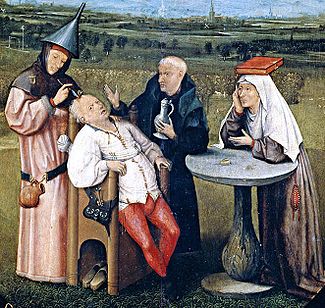
Trepanning, also known as trepanation, trephination, trephining or making a burr hole (the verb trepan derives from Old French from Medieval Latin trepanum from Greek trúpanon, literally "borer, auger"),[1][2] is a surgical intervention in which a hole is drilled or scraped into the human skull. The intentional perforation of the cranium exposes the dura mater to treat health problems related to intracranial diseases or release pressured blood buildup from an injury. It may also refer to any "burr" hole created through other body surfaces, including nail beds. A trephine is an instrument used for cutting out a round piece of skull bone to relieve pressure beneath a surface.[citation needed]
In ancient times, holes were drilled into a person who was behaving in what was considered an abnormal way to let out what people believed were evil spirits.[3] Evidence of trepanation has been found in prehistoric human remains from Neolithic times onward. The bone that was trepanned was kept by the prehistoric people and may have been worn as a charm to keep evil spirits away. Evidence also suggests that trepanation was primitive emergency surgery after head wounds[4] to remove shattered bits of bone from a fractured skull and clean out the blood that often pools under the skull after a blow to the head. Hunting accidents, falls, wild animals, and weapons such as clubs or spears could have caused such injuries. Trepanations appear to have been most common in areas where weapons that could produce skull fractures were used.[5] The primary theories for the practice of trepanation in ancient times include spiritual purposes and treatment for epilepsy, head wound, mental disorders, and headache, although the latter may be just an unfounded myth.[6][7]
In modern eye surgery, a trephine instrument is used in corneal transplant surgery. The procedure of drilling a hole through a fingernail or toenail is also known as trephination. It is performed by a physician or surgeon to relieve the pain associated with a subungual hematoma (blood under the nail); a small amount of blood is expressed through the hole and the pain associated with the pressure is partially alleviated. Similarly, in abdominal surgery, a trephine incision is when a small disc of abdominal skin is excised to accommodate a stoma. Although the abdominal wall does not contain bone, the use of the word trephine in this context may relate to the round excised area of skin being similar in shape to a burr hole.
- ^ Harper, Douglas. "trepan". Online Etymology Dictionary.
- ^ τρύπανον. Liddell, Henry George; Scott, Robert; A Greek–English Lexicon at the Perseus Project. Liddell, Henry George; Scott, Robert; A Greek–English Lexicon at the Perseus Project.
- ^ Nolen-Hoeksema (2014). Abnormal Psychology (6th ed.). McGraw-Hill Education.
- ^ Cite error: The named reference
Weberwas invoked but never defined (see the help page). - ^ Rogers, Spencer (1985). Primitive Surgery: Skills Before Science. Springfield, IL: Charles C. Thomas. pp. 17-18. ISBN 0-398-05123-2.
- ^ Cite error: The named reference
:2was invoked but never defined (see the help page). - ^ Butticè, Claudio (April 2022). What you need to know about headaches. Santa Barbara, California: Greenwood Publishing Group. pp. 29–30. ISBN 978-1-4408-7531-1. OCLC 1259297708.